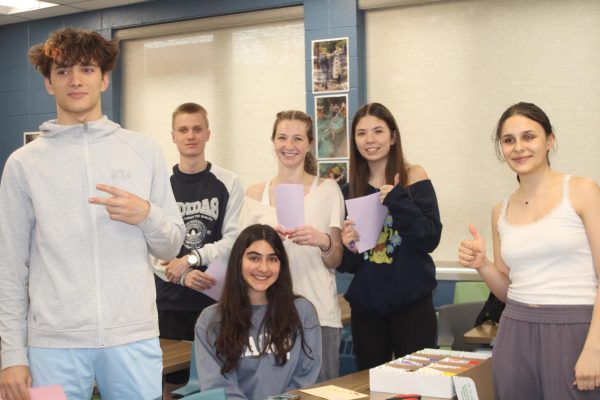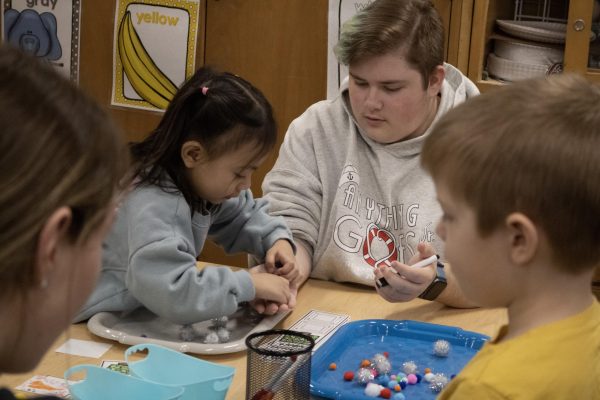Child Development students share smiles with ‘Titan Tots’ toddlers
March 21, 2017
No two classes are the same in the Child Development curriculum. Unlike some classes of sitting still and note-taking, South students in these classes become the teachers as they work with children of various ages. This course, according to teacher Kim Kiraly, gives students interested in children or a potential teaching career a unique and interactive experience through all levels of the course.
According to Kiraly, the first three levels of Child Development provide students with a chance to learn the basics of child development and how to care for children. This is done by instructing them on how to teach students in the preschool within South, Titan Tots. According to sophomore Maddie Carrane, students in the class are able to gain a unique experience in regards to teaching and working with children.
“It’s so cool that you actually get to learn how to be a teacher,” Carrane said. “You put your all into [the class] and then actually go in and teach the kids, and your hard work really pays off.”
Unlike the other course levels, according to Kiraly, the fourth level of the course has students leave campus to teach at schools such as OLPH and Lyon School for one block every other day. According to senior Maude Tarbox, a student in Child Development 461, the firsthand experience that teaching children in other schools provides can help foster a student’s passion for either teaching or working with children in general.
“My first time doing [level 461], the kids on my last day […] gave me a book that they all had their picture in and they wrote to me and decorated it, and they all started screaming ‘Don’t leave!’ when I left, and it was so touching,” Tarbox said. “I realized for the first time that I could have an impact on their lives.”
The best part of the course, however, is the children themselves, according to senior Kenny McMahon. According to McMahon, although he’s the only boy in Child Development 461, he doesn’t allow the gender stigma surrounding the course to stop him from doing what he’s passionate about.
“[The kids are] so much fun and the smile on their face at the end of the day makes it all worth it,” McMahon said. “They don’t usually get to see male teachers at the elementary school age, […] so when they see a boy walk into the classroom, it’s definitely something different for them.”
Although immersion into elementary classes increases with the course level, according to Titan Tots teacher Michelle Goodrich, all levels of Child Development ascertain students can use their current skills to build off of what they learn in the classroom.
“It’s a really great opportunity for them to be working in the preschool,” Goodrich said. “It gives them a hands-on approach to taking what they’re learning in the Child Development classes and then using that firsthand in the preschool.”
Child Development can also teach students lessons that pertain to many things outside working and teaching with kids, according to McMahon, such as learning how to deal with the unexpected.
“[It was] the third day I had teaching […] and a little kid is tugging on the sleeve of my shirt, and I look down and he looks back up at me, and he says, ‘Mr. McMahon, Matthew’s being silly in the bathroom,’” McMahon said. “He flooded the entire bathroom. He took as many paper towels as his tiny hands could possibly hold and shoved them down every drain he could find, and he wasn’t sorry about it. […] You never know what to expect with little kids.”
According to Tarbox, taking all four course levels can help teach students these lessons even further as the interactive experience that students receive within classrooms outside of school is completely different from what they learn in the first Child Development courses. McMahon agrees, and believes that teaching outside of South is a great way to learn more about children and education.
“You don’t know what will set them off and what will cause a tantrum,” McMahon said. “Being around that makes you able to deal with [the unexpected] when it does happen, because nothing with Kiraly or what you read in [a] book or see in [a] video is going to prepare you for when you have a five-year-old that broke the tip of his pencil and is throwing a tantrum for no reason.”
According to Kiraly, despite what may happen on a daily basis in both the preschool and schools outside of South, working directly with children has helped many students in the course grow as both students and teachers.
“When kids trust you and look up to you and when you’re a role model to a classroom of [children] that truly want to see you every day and miss you when you’re gone, that’s a really rewarding experience, and I think that the high school students [in the course] connect with that,” Kiraly said.













